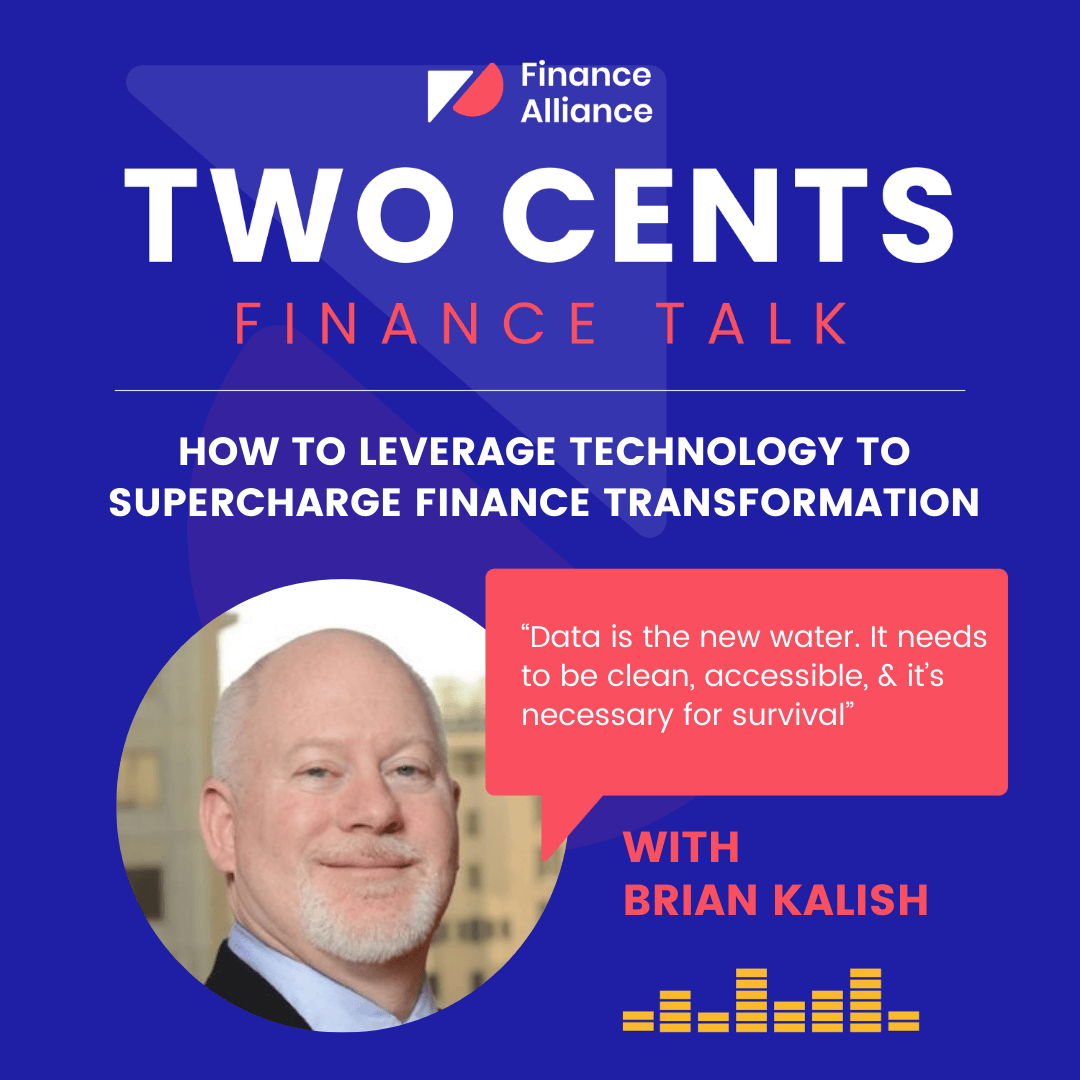FP&A leaders are expected to deliver speedy insights to support important strategic decisions. This clear ‘need for speed’ increased during the pandemic. It shone a blinding light on the deficiencies in the process and technology infrastructures of organizations around the globe. A lack of data visibility and sub-optimized forecasting and planning processes are likely to blame for the issues... but what's the solution?
Brian Kalish, Principal and Founder of Kalish Consulting, revealed the answer on the Two Cents: Finance Talk podcast. We chatted about everything from leveraging technology to supercharge real finance digital transformation to whether artificial intelligence (and finance automation) will eventually eliminate FP&A.
You can listen to this episode of the Two Cents podcast here or keep reading to discover:
- How the roles of FP&A professionals have evolved
- How to get a ‘seat at the table’ (even if you aren’t the CFO)
- Why finance teams are moving towards a process redesign for certain processes
- Will finance automation tools and artificial intelligence make FP&A redundant?
- How to spearhead finance digital transformation in an organization
- How to use data to enable decision-making support through advanced analytics
How finance automation (and the pandemic) changed the role of FP&A professionals
The role of the FP&A team is to provide data, metrics, and insights to inform major decisions made by the executives of a company. The core responsibilities of FP&A teams haven’t completely changed because of the pandemic. But, they have evolved.
Obviously, nobody wants to go through a pandemic. Yet, history has taught us that this type of event often increases innovation and technological advancement because of necessity.
“The need to know what's going on in the world and your business has never been greater because these changes are happening so fast.” – Brian Kalish
Brian mentioned a quote he heard from the CEO of a Fortune 100 company that emphasizes just how much finance teams have evolved (and not always by choice!)
“My aspiration is for my finance team to be able to react to any change in the business within 90 seconds.”
Reacting to an event or crisis within such a short space of time is a very difficult thing to do. Some might even call it impossible or irrational to expect so much from someone.
When pressed about it, the CEO said she based it on how the stock market works. They react fast. And finance teams need to react fast too.
But how do you react immediately if you don’t have the digital technology or business intelligence to help? You may be a superhuman with numbers, but you probably don't have superhuman speed (where's the Flash when you need him?).
So, what’s the solution?
Brian shared his two cents on the matter:
“We want to get access to our data faster, provide insights to the business faster, and the organization itself wants to make better, faster, and smarter decisions…"

"People talk about how important big data is like it's the new oil or the new gold. People have said it's the new superpower. I believe data is the new water in the sense that it needs to be clean, accessible and it's necessary for survival.” – Brian Kalish
How to partner with the business and embrace finance automation (even if you’re not the CFO)
Finance professionals such as CFOs and FP&A leaders build partnerships with the business by doing two things – solving problems and answering questions. It's that simple.
Financial reporting is about looking at the horizon and seeking opportunities for growth while assessing potential risks.
Lately, there's been a huge change. Businesses want more from their finance teams and business partnering seems to be the best way forward.
Businesses are no longer interested in POCs (proof of concept). They’re more interested in POV (proof of value). Therefore, you must consider what the organization wants.
“It’s essential to understand what the organization wants. If we're keeping it in the context of analytics that we can provide the organization, there has to be a consumer of those analytics."
"Once you start getting into predictive, prescriptive, and then cognitive - just because we can do it, doesn't mean the company wants to do it.” – Brian Kalish

Brian believes that technology and finance digital transformation can answer every business question. But, the organization must ask these three questions first:
- Do we want to ask the question?
- Do we want to do predictive analytics?
- Do we want to get into prescriptive?
If it's no, stop. If it's yes, move to the next question…
4. Do we have the resources to get it from capacity, people, process, and the money spent on technology?
If the answer is no, you stop again. If it’s yes, it leads to the final and most important question of all...
5. Is the ROI going to be high enough to justify the spending?
It’s all well and good trying things out, but it must make economic sense for an organization to do so.

If you need to convince the C-Suite that it's time for digital transformation, you may run into some roadblocks along the way. Your best bet is to focus on how the business and stakeholders can leverage finance to help make better, smarter, and faster decisions.
Brian explained why FP&A teams face so many challenges before they even reach the C-Suite…
“Nobody likes us. I'll sit there and talk about how incredibly important FP&A is all day long but we're overhead, we’re not generating."
"One of the questions I always find interesting is, who does FP&A well? Are there any indicators? Concentration? And my answer to it is no…"
“It has nothing to do with geography, the size of the organization, or the industry you’re in. It comes down to people, processes, technology, and culture. The businesses want us to help them, we just have to talk.” – Brian Kalish
It’s not enough for finance teams to present the C-Suite with a stack of reports. Not everyone can read or understand what the data means. When you present to the C-Suite, you’ve got to give them the story behind the numbers.
“The challenge is that finance generates a whole bunch of reports but not necessarily insight. These reports are sent out to the business, and we have no idea if the business does anything with them."
"The business takes these reports of data and information and doesn't do anything with it because it's not giving them any insights or information that's actionable.” – Brian Kalish
How finance automation and finance transformation is shifting process redesign
A common mistake that finance teams make is ‘doing a lift and shift.’ This is when you bring in new technology to do the same thing you were doing yesterday.
If you have bad processes and you bring in a new system, you’re left with bad processes operating faster. You haven’t resolved the issue.
“When you're trying to change something that already exists, change is hard.”
“The idea is that we sometimes have these very complex processes. We understand that we're bringing in new technology and that it’s incredibly under-utilizing the technology if we do this ‘lift and shift’.”
“The willingness to think about how we do things, and why we do things, has greatly expanded and it's only been supercharged during the pandemic.” – Brian Kalish
Will artificial intelligence and finance automation eliminate FP&A?
There’s no doubt that finance leaders have embraced technology. Despite new technology providers emerging, many FP&A professionals still prefer to use spreadsheets on Microsoft Excel for planning, budgeting, and forecasting. However, many are searching for alternatives to Microsoft and this is where machine-learning, APIs (application programming interface software), automated bots, and artificial intelligence step in.
With the rise of finance automated technology, many FP&A professionals are concerned that their roles may be jeopardized. This is something that Brian talked very passionately about during our conversation on the Two Cents: Finance Talk podcast.
According to Brian, RPA (robotic process automation) shouldn’t be feared or avoided. The truth is that finance automation equals liberation.
“Organizations need to not only not fear automation but embrace it and make it a competitive advantage.” – Brian Kalish
Artificial intelligence (and ‘the bots’) won’t make your role as an FP&A professional obsolete. Rather, things like machine learning and automated apps can help you automate, optimize, and streamline business processes for even better performance and workflow.

Of course, it’s natural to be on the fence about this. After all, we’re only humans and humans hate change (most of the time). However, that doesn’t mean we should avoid it completely. If RPA can automate those repetitive, tedious tasks that you dread every day, why not take the initiative and let it?
Here are a few words of advice from Brian for anyone who worries that AI is coming for their job in finance:
“I embrace finance automation and machine learning in artificial intelligence because it gets us to a better place. But I also think those earlier adopters are going to be the ones who win. If you wait too long, you can't make up the distance.” – Brian Kalish
How to spearhead finance automation in your organization
If you’re the CFO, you’re in one of the best possible positions to spearhead the change you want to see in the company. But, it’ll be a difficult feat for anyone who doesn’t have a permanent seat at the table.
So, what's the solution?
Well… you need to have a champion in the C-Suite. You need somebody who will fight for you because most people will fight against you.
Put simply, if you want to implement digital transformation and finance automation as an FP&A professional, you've got to have organizational leverage to be able to push it through.
Of course, not everyone can be the CFO of a company. So, here’s what you should do…
Firstly, start in your own backyard. You can't tell other people how they should change if you haven't changed yourself.
“Once people see that you can change and change for the better, most people want to emulate that.” – Brian Kalish
How to use big data finance automation to enable decision-making support
Companies want to make decisions in real-time with their data. And now, thanks to advancements in data management, ERP (enterprise resource planning), and other technologies, they can.
SaaS companies are leading the way when it comes to utilizing digital technology with things such as cybersecurity, customer experience, and increasing profitability. And, with more SaaS startups emerging, we’ll likely see even more ground-breaking technology enter the finance ecosystem sooner rather than later. We’ve also seen a huge movement towards FinTech, which competes with the traditional support and delivery of financial services.
But how are finance functions leveraging big data for their everyday responsibilities?
Brian shared some interesting insights into how the CFO and others can utilize big data to support decisions through advanced analytics.
Let’s take a closer look at what he had to say…
“We all love the fact that we have the Cloud now. What people love about the Cloud, at least in finance, is that it's unleashed this tremendous plethora of products. There are all these new planning, data analytics, and forecasting tools. The onus is now on finance to understand the tools they want."
"What isn't going to work is the idea that there's some system or product out there that's going to acquire my data, and do all my financing, forecasting, and planning. We're going to be moving much more to a best-in-class model because we'll find the components that do different parts better.” – Brian Kalish
Another issue that Brian talked about was getting everyone on the same platform, which he argues is nothing more than a fool’s errand.
Why?
Well, most organizations aren’t on the same platform. And, even if they are, they’re not using the same version because technology is constantly changing.
“What's happened now is this concept of what I call ‘data stitching’. You're not so worried about where the data is coming from, it's about what you are doing with it."
"For 30 years, we've had this concept about the data warehouse. And, it's bringing the data in, transforming it into a readable format, and then you pull pieces out. That's called Extract, Transform, and Load (ETL).” – Brian Kalish
What's changed for finance and FP&A is switching the letters, so it's going to extract, load, and then transform. The idea is instead of a data warehouse, it's more of a data lake where you're taking the data and putting it in the same place.
So, what's the difference? (I hear you ask)
The answer is speed.
“You can pull out the pieces and analyze to the point that you can see what's happening in your business in real-time. If you think about it, you have a transaction at a cost and suddenly someone in finance can see it occur. That level of granularity is what we've always been chasing."
"When we take this strategy of data stitching, we can take it all the way down to the transactional level. Then, we can tie everything out to the penny and you can do that because of the speed.”
“Finance doesn’t care about your technology. I don't care how it works or what it is. When I walk into a room, I flip a switch and the lights go on. But I don't need to be an electrical engineer to understand how that works."
"When people ask 'I have this new technology, what do you think people would be excited about?' I tell them, 'how is it helping me solve a problem?'" – Brian Kalish
What advice do you have for someone who wants to take the next step in their finance career?
Want to hear more from Brian? Tune in to the full podcast episode here and don't forget to subscribe for more!
Want to continue this conversation about finance automation with other CFOs and FP&A leaders?
Sign up to our free Finance Alliance Slack community and start networking with other CFOs and finance leaders today!




 Follow us on LinkedIn
Follow us on LinkedIn




